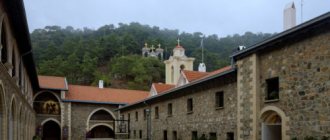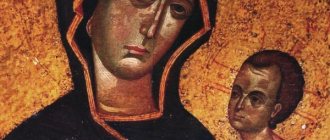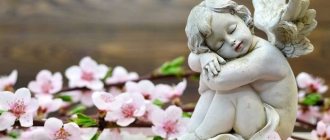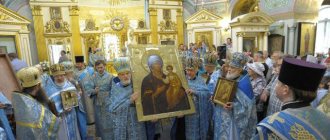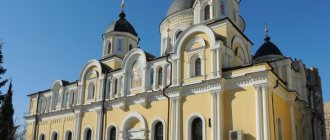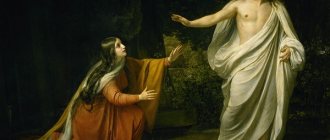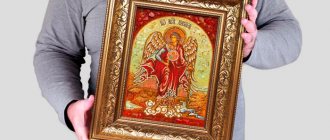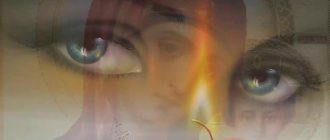Story
Initially, the icon was in Egypt, in one of the first Christian communities, to which the Apostle Luke himself gave it. In 980, when the Muslim Arabs who conquered Egypt began to persecute Christians, the Kykkos Icon was taken to Constantinople.
At the beginning of the 12th century, a sign was shown to the hermit Isaiah that he should help bring the icon of the Mother of God of Kykkos to the island of Cyprus
This is what ultimately happened, but there was a long history before it.
Once Isaiah was walking along a mountain path, immersed in prayer, and did not notice the Byzantine governor Manuel Voutomis, who got lost here while hunting. The hot-tempered Manuel hit the elder because he did not greet him as expected.
After some time, the governor was seized by an incomprehensible illness that paralyzed him. Sensing death, he confessed his sins to the priest and remembered, among other things, how he beat the old monk. Then he realized that illness was a punishment for a sin committed, and ordered to find the elder.
When those close to him found Isaiah, during prayer he had a vision that in Cyprus, on the Kykkos rock, a monastery should be built for the Most Holy Theotokos, which would become her eternal refuge.
After the hermit’s prayer, Manuel was healed, and Isaiah, in gratitude for this, asked that the Kykkos Icon of the Mother of God be transported from Byzantium to Cyprus.
Kykkos Monastery
It is in this stravropegial monastery that the image of Our Lady of Mercy is kept. Another name for this richest and most famous Cypriot monastery is the Holy Royal Monastery of the Kykkos Image of the Virgin Mary.
The founder of the monastery was the ruler of Byzantium, Alexy Komnenos. Its buildings are located at an altitude of 1140 meters above sea level, near the Troodos (mountain system). The buildings existing there at the moment can be attributed to different historical periods.
The central part of the complex is occupied by a temple. Along its perimeter are located:
- monastic cells;
- reception halls;
- cathedral room;
- the rector's house;
- museum;
- library.
Not far from the monastery there is a bell tower, built in 1882. It houses a huge bell, weighing more than a ton, a gift to the monastery from Tsarist Russia. In addition, on the territory of the monastery there is a paved courtyard with a well dug in the center.
Initially, all the premises were wooden, since the peak of Mount Kykkos is located near the Paphos forest, and wood was the most accessible material for construction. The inner surface of the monastery was decorated with frescoes and mosaics, but this happened only in 1991-1993. The authors of the images were the Kipola brothers, as well as other Romanian and Greek masters.
How the Kykkos Icon of the Mother of God came to Cyprus
Having been healed, Manuel immediately went to Emperor Alexy, whose daughter was sick with a similar illness, and told about the monk’s miraculous prayer. Isaiah agreed to heal the girl, but set a condition: to give him the icon if she recovered. After his prayer, the girl was healed, but the emperor really did not want to give up the “Merciful” icon, and he resorted to a trick.
An exact copy was made of the icon, and Isaiah had to recognize the original. He was helped by a bee that landed on a real icon, and the emperor had to fulfill his promise.
When the icon arrived in Cyprus, the residents greeted it with a solemn religious procession, and even the trees bowed before the shrine (they remain so to this day). At the expense of the healed Manuel, a monastery was built on Mount Kykkos, from which it received its name. Pilgrims still flock to the miraculous icon, and it helps not only Christians, but also all those who suffer, regardless of faith.
Orthodox Life
Orthodoxy.fm
For any Orthodox person, an icon is an object of special veneration. We pray to them, pour out our pain and sadness, and thank them for their help and assistance. And we apply ourselves. And we teach children to apply themselves. For this is the minimum gratitude to the saint that we can express in church. We look into the eyes, the holy eyes of those depicted on the icon, and believe that help will come! Support will come! Strengthening will come! Everything will work out!
The main icon of Cyprus, the Kykkos Icon of the Mother of God, is unique. Anyone can come and pray near her, but no one can venerate her. Why, no one is allowed to venerate the face of the Mother of God of Kykkos! It is covered with a frame, the frame is covered with a shroud. True, the frame depicts a face from the icon, but this is only a list.
Personally, for the first time in my life I encountered such a phenomenon. There is an icon, but you cannot see it. How so? Why? This icon is called Kykkos from the name of Mount Kykkos on the island of Cyprus. The icon is called a merciful one because the Mother of God is depicted on it beseeching the Son and Her God for the salvation of the Christian race. This is what we can see on the salary.
To begin with, I will say that this image is also attributed to the authorship of the Evangelist Luke. He painted more than one image of the Mother of God, known to us as “Vladimirskaya”. He wrote the Kykkos image for Egyptian Christians, who, unfortunately, also experienced a period of iconoclasm. And in order to save the icon from the hands of the raging vandals, it was “evacuated” to Byzantium. But along the way, the ship carrying the icon was attacked by a group of pirates - Arab sea robbers. They did nothing to the icon, moreover, they weren’t even interested in it. They were interested in earthly, or rather, mundane riches much more than religious disputes with Christians. Thus, the icon was saved and eventually ended up in Constantinople, where Orthodoxy triumphed, having defeated the iconoclastic heresy.
Then miracles begin. One day, Emperor Alexius Komnenos’s daughter fell ill with a serious illness. The father was inconsolable. At this time, Emperor Manuel’s commander from the island of Cyprus arrived in Constantinople, who had a vision of asking Emperor Alexy for a miraculous icon to build a monastery on the Cypriot Mount Kykkos. The emperor, concerned about only one thing - the health of his daughter - promised. And lo and behold, soon after this his sick daughter was miraculously healed. It would seem - fall to your knees, thank the Lord and fulfill the covenants. But no! The emperor felt sorry for giving away the icon of the Mother of God, and he began to delay the fulfillment of his promise. Probably without even realizing that “the second can be much worse than the first.” And soon he fell ill himself.
But God is merciful. In a dream, the Most Pure Virgin herself appeared to the ruler and strictly ordered him to send the icon to Cyprus. There was nothing to be done, and the emperor ordered the ship to be equipped.
Here, on Mount Kykkos, a temple was built and a monastery attached to the temple, which received the name Imperial, since Alexei contributed financially to the construction of the monastery. A worthy and beautiful monastery in which his favorite icon would “live.” But her face is closed to everyone to this day. And those who are curious, or more precisely, those who disobey, suffer punishment. In particular, in Cyprus they tell a story that when the Patriarch of Alexandria only lifted his veil, he immediately became blind. He was so frightened that he began to beg for forgiveness and ask for mercy, loudly declaring that he was wrong and disobeyed the command of the Mother of God. His vision returned. But everyone was taught a lesson: it’s impossible - it means it’s impossible! In 1771, Hieromonk John of Rhodes from Jerusalem, who tried to open the curtain to see the icon, was dumbfounded and speechless for several hours. Therefore, it doesn’t matter who you are - a vagabond, a layman, a priest or a Patriarch - the law is the same for everyone and everyone equally.
Ephraim the Athenian writes that the icon was covered with a cloth during transportation from Constantinople and has been kept that way ever since. However, since there are many copies of the icon in Cyprus, apparently it was not immediately hidden from view. Seraphim the Pissidian, who prepared a revised and expanded edition of the “Description of the Kykkos Monastery” in 1782, also thinks the same: “The sage of this century says:
“Well, when this holy icon was taken to Egypt... was not the all-holy face of the holy icon uncovered? Undoubtedly so. And then, when she was in the royal palace for so many years, it also remained open? Certainly.
“Okay,” he says. “Then why doesn’t She want to show Her appearance now, as She showed everyone before?”
Man, this is God’s Providence... for the sake of some goals that God foresees, but we do not know. And after all, the icon remained uncovered not only when it was in the royal palace, but also in 1577, six years after the Ottoman conquest, it was decorated with a frame, and those who decorated it, of course, saw the appearance of the Mother of God and Christ's Holy Face . Only now it is invisible to everyone, so that those who tried to open the cover with which the holy icon was covered were subjected to severe punishment from the Most Holy Mother of God, as is narrated in the “Description”, despite the fact that those who undertook these attempts, were virtuous men and men of God. This, man, is God’s providence and care for us...”
The chronicle of the Kykkos monastery tells about the fourfold salvation of the monastery from fire, miraculous healings, the gift of long-awaited children, the sending of rain in dry, lean years, and the salvation of the monastery from an invasion of locusts. The Kykkos icon, which has become the most revered on the island of Cyprus, wards off any misfortune from the holy monastery. One monk, mute from birth, standing by the icon, spoke. Another dying monk suddenly became healthy, only by praying to the wondrous, hidden image. The pagan, who swung at the shrine, immediately withered his hand. As a reminder of this, an iron hand was hung next to the icon.
We can see this icon and know what is depicted on it only from the lists that have reached us. Fortunately, there are a lot of them. The Mother of God sits on the throne, turning to the left and bending towards the Infant God. Their figures are inscribed in an arch, above which there are medallions with Archangels worshiping them. Icon type – Leap. The Infant of God is restless, and the Mother of God pacifies Him. There are two veils - the veil on the head of the Virgin Mary: red and dark. The most famous miraculous copy of the “Kykkos-Merciful” icon today is kept in the Conception Stauropegic Convent. It is somewhat different from the original from the veil, but very similar in many ways.
Before the icon of the Most Holy Theotokos “Merciful” they pray for deliverance from drought, for healing from bleeding, infertility and the gift of childbearing, for strengthening in needs and sorrows, for help in bearing the monastic cross, for healing from headaches, for the healing of the paralytic and in family sorrows . The Queen of Heaven hears everything and tries to help her children on earth in everything.
Wonderful are the works of the Lord! And I want to finish my story about the Kykkos icon with a line from its magnification: “We magnify You, Most Holy Virgin, and honor Your holy image, through which you heal our illnesses and raise our souls to God!”
Victoria Hristova
Veil of the Virgin Mary
It is not known exactly when the “Merciful” icon of the Mother of God of Kykkos was covered with a veil covering the holy faces, and now it is constantly hidden behind a red velvet veil. Only once a year is the face of the Mother of God revealed during a prayer service, but there is a legend that the patriarch who dared to look directly into Her eyes was once blinded.
Description of the icon
According to the iconographic type, the icon of the Mother of God “Merciful” belongs to the type “Eleusa” (Merciful, Tenderness), which is characterized by the fact that the Baby Jesus presses his cheek to the Mother’s cheek.
The meaning of this gesture lies in the expression of boundless love not only between the Son and Mother, but also in their love for all humanity
In the Greek iconographic canon, this type of icon is called Glykofilusa (Sweet Kiss). At the same time, there is a certain similarity with the Hodegetria, since both chapters are crowned.
How does the Kykkos Icon of the Mother of God help?
In Russia, the icon of the Mother of God “Merciful” in the Conception Monastery enjoys special veneration.
People turn to her with any requests of a general or private nature, be it salvation from natural disasters, epidemics or drought, and even to the prayer to the Kykkos icon for healing from infertility, deafness, dumbness, bleeding, etc. The miraculous icon helps resolve any misfortunes: it restores peace in family, solves financial problems.
Veneration of the icon on November 25 and January 8.
The Kykkos Mother of God helps in conceiving a child and getting rid of infertility
What does it help with and what do they pray to the Mother of God of Kykkos? They pray to her:
- about rain in dry times;
- about conceiving a child;
- about cure for female infertility;
- from getting rid of deafness, muteness;
- from getting rid of headaches, bleeding;
- about the end of terrible disasters on earth;
- about ending the lack of money;
- about salvation from epidemics.
The Mother of God of Kykkos could pull a person straight from the other world. You don’t have to read complex and long words of prayer, but simply turn to the Mother of God for help in your own words.
Prayer to the icon
O Most Holy and Blessed Mother of our Lord, God and Savior Jesus Christ, Merciful Mother of God and Ever-Virgin Mary! Falling before Your holy and miraculous icon, we humbly pray to You, our Good and Merciful Intercessor: listen to the voice of our sinful prayers, do not despise the sighs from the soul, seeing the sorrows and misfortunes that have befallen us, and like a truly loving Mother, striving to help us helpless, sad, Those who have fallen into many and grave sins and continually anger our Lord and Creator, pray to Him, our Representative, not to destroy us with our iniquities, but to show us His philanthropic mercy. Ask us, O Lady, from His goodness, bodily health and spiritual salvation, a pious and peaceful life, fruitful earth, goodness of the air, well-timed rains and a blessing from above for all our good deeds and undertakings, and as of old you mercifully looked upon the humble doxology of the novice of Athonite. , who sang a song of praise to You before Your Most Pure Icon, and You sent Archangel Gabriel to him to teach him to sing the heavenly song, with which the angels of the mountain glorify You, graciously accept our prayer now fervently offered to You, and bring it to Your Son and God, may He be merciful He will be a sinner for us, and He will add His mercy to all who honor Thee and worship Thy Holy Image with faith.
O All-Merciful Queen, All-merciful Mother of God, stretch out your God-bearing hands to Him, in His image, as if you were carrying a baby, and beg Him to save us all and deliver us from eternal destruction. Show us, O Lady, Your generosity: heal the sick, comfort the sorrowing, help the needy: make us all prosperous to bear the yoke of Christ in patience and humility, grant us a pious end to this earthly life, receive a Christian shameless death, and inherit the Heavenly Kingdom, through Your maternal intercession to To Christ our God, who was born of You, and to Him with His Originless Father and the Most Holy Spirit, befits all glory, honor and worship, now and ever, and unto the ages of ages. Amen.
( 1 ratings, average: 5.00 out of 5)

